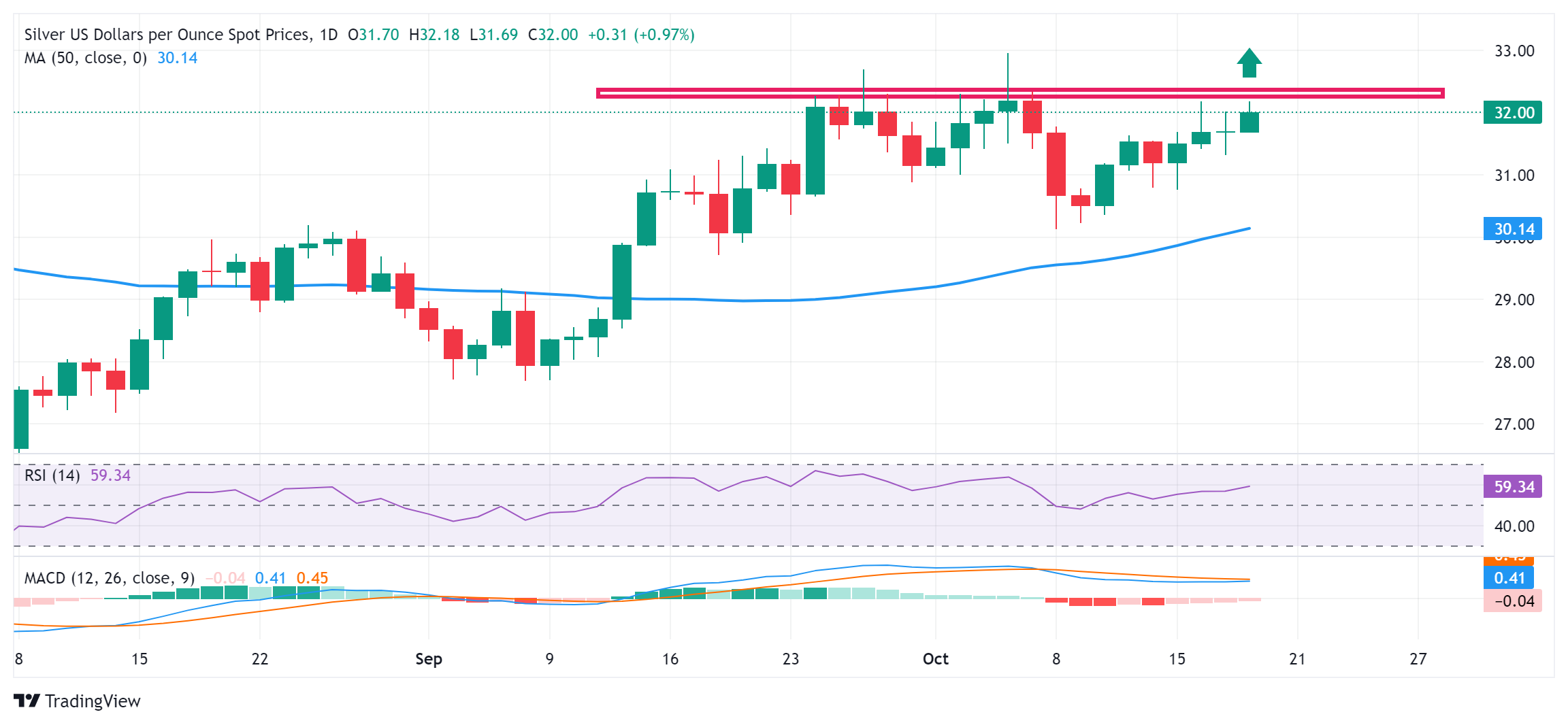Silver Price Forecast: XAG/USD bulls look to build on momentum beyond $32.00 mark

- Silver regains positive traction on Friday and climbs to a nearly two-week top.
- The technical setup favors bulls and supports prospects for additional gains.
- Move beyond $32.20-$32.25 is needed to validate the near-term positive bias.
Silver (XAG/USD) regains positive traction following the previous day’s good two-way price moves and climbs to a two-week top during the first half of the European session on Friday. The white metal, however, continues with its struggle to capitalize on the move beyond the $32.00 round figure, warranting some caution for bullish traders.
Looking at the broader picture, the recent bounce from the vicinity of the $30.00 psychological mark and the subsequent move up supports prospects for a further near-term appreciating move. The constructive outlook is reinforced by the fact that oscillators on the daily chart have been gaining positive traction and are still away from being in the overbought zone.
That said, it will still be prudent to wait for some follow-through buying beyond the $32.20-$32.25 hurdle before placing fresh bullish bets. The XAG/USD might then climb to its highest level since December 2012 touched earlier this month and make a fresh attempt to conquer the $33.00 mark. A sustained strength beyond the latter will be seen as a fresh trigger for bulls.
On the flip side, the $31.65 horizontal zone now seems to protect the immediate downside ahead of the overnight swing low, around the $31.30 region. Any further decline could be seen as a buying opportunity and remain limited near the $31.00 mark. A convincing break below the said handle, however, might prompt some technical selling and make the XAG/USD vulnerable.
The downward trajectory might then drag the white metal below the $30.75 support zone, back towards last week’s swing low, around the $30.15-$30.10 region. The said area now coincides with the 50-day Simple Moving Average (SMA) and is closely followed by the $30.00 mark, which if broken decisively will shift the near-term bias in favor of bearish traders.
Silver daily chart
Silver FAQs
Silver is a precious metal highly traded among investors. It has been historically used as a store of value and a medium of exchange. Although less popular than Gold, traders may turn to Silver to diversify their investment portfolio, for its intrinsic value or as a potential hedge during high-inflation periods. Investors can buy physical Silver, in coins or in bars, or trade it through vehicles such as Exchange Traded Funds, which track its price on international markets.
Silver prices can move due to a wide range of factors. Geopolitical instability or fears of a deep recession can make Silver price escalate due to its safe-haven status, although to a lesser extent than Gold’s. As a yieldless asset, Silver tends to rise with lower interest rates. Its moves also depend on how the US Dollar (USD) behaves as the asset is priced in dollars (XAG/USD). A strong Dollar tends to keep the price of Silver at bay, whereas a weaker Dollar is likely to propel prices up. Other factors such as investment demand, mining supply – Silver is much more abundant than Gold – and recycling rates can also affect prices.
Silver is widely used in industry, particularly in sectors such as electronics or solar energy, as it has one of the highest electric conductivity of all metals – more than Copper and Gold. A surge in demand can increase prices, while a decline tends to lower them. Dynamics in the US, Chinese and Indian economies can also contribute to price swings: for the US and particularly China, their big industrial sectors use Silver in various processes; in India, consumers’ demand for the precious metal for jewellery also plays a key role in setting prices.
Silver prices tend to follow Gold’s moves. When Gold prices rise, Silver typically follows suit, as their status as safe-haven assets is similar. The Gold/Silver ratio, which shows the number of ounces of Silver needed to equal the value of one ounce of Gold, may help to determine the relative valuation between both metals. Some investors may consider a high ratio as an indicator that Silver is undervalued, or Gold is overvalued. On the contrary, a low ratio might suggest that Gold is undervalued relative to Silver.
